Prevalence and serotype distribution of nasopharyngeal carriage of Streptococcus pneumoniae in China: a meta-analysis
- PMID: 29237402
- PMCID: PMC5729489
- DOI: 10.1186/s12879-017-2816-8
Prevalence and serotype distribution of nasopharyngeal carriage of Streptococcus pneumoniae in China: a meta-analysis
Abstract
Background: To explore the overall prevalence and serotype distribution of nasopharyngeal carriage of Streptococcus pneumoniae(S. pneumoniae) among healthy children.
Methods: A search for pneumococcal nasopharyngeal carriage studies including children published up to July 31th, 2016 was conducted to describe carriage in China. The review also describes antibiotic resistance in and serotypes of S. pneumoniae and assesses the impact of vaccination on carriage in this region. Summary measures for overall prevalence, antibiotic resistance, and serotype distributions extracted from the analyzed data were determined with 95% confidence intervals (CIs) using random-effects models. Heterogeneity was assessed using I 2 test statistics.
Results: Thirty-seven studies were included in this review, and the majority of studies (64.9%) were located in the pre-introduction period of 7-valent pneumococcal conjugate vaccine (PCV7) in China. The pooled prevalence of S. pneumoniae nasopharyngeal carriage was 21.4% (95% CI: 18.3-24.4%). Carriage was highest in children attending kindergartens [24.5%, (19.7-29.3%)] and decreased with increasing age. Before the introduction of PCV7 into China, the prevalence of S. pneumoniae nasopharyngeal carriage was 25.8% (20.7-30.9%), the pooled carriage of S. pneumoniae sharply dropped into the 14.1% (11.3-16.9%) by PCV7 vaccination period (P < 0.001). Before the pneumococcal conjugate vaccine (PCV) was introduced in China, the penicillin resistance rate in S. pneumoniae isolated from healthy children was 31.9% (21.2-42.6%); however, this rate sharply decreased after the introduction of PCV7 in China [21.6%, (7.4-35.9%)], and the difference between the rates during these two time periods was statistically significant (P value <0.05). Serotypes 19F, 6A and 23F were the most commonly isolated. Meta-analysis of data from young children showed a pooled rate estimate of 46.6% (38.8-54.4%) for PCV7 vaccine coverage and 66.2% (58.6-73.8%) for PCV13 vaccine coverage.
Conclusions: The prevalence of nasopharyngeal carriage among children was high in China. PCV7 immunization was found to be associated with reduction of nasopharyngeal colonization of S. pneumoniae. Conjugate vaccination coverage was slightly affected by the introduction of PCV7 into China because of low vaccination rate. The government should implement timely adjusted conjugate vaccination strategies based on our findings.
Keywords: Healthy children; Meta-analysis; Serotype distribution; Streptococcus Pneumoniae.
Conflict of interest statement
Ethics approval and consent to participate
This study was approved by the Institutional Review Board of Liuzhou Maternity and Child Healthcare Hospital.
Consent for publication
Not applicable.
Competing interests
The authors declare that they have no competing interests.
Publisher’s Note
Springer Nature remains neutral with regard to jurisdictional claims in published maps and institutional affiliations.
Figures
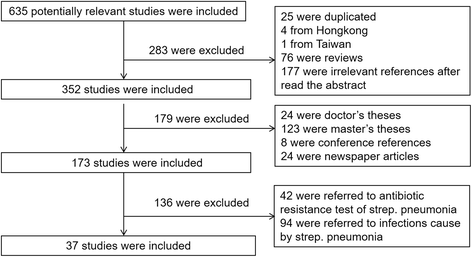
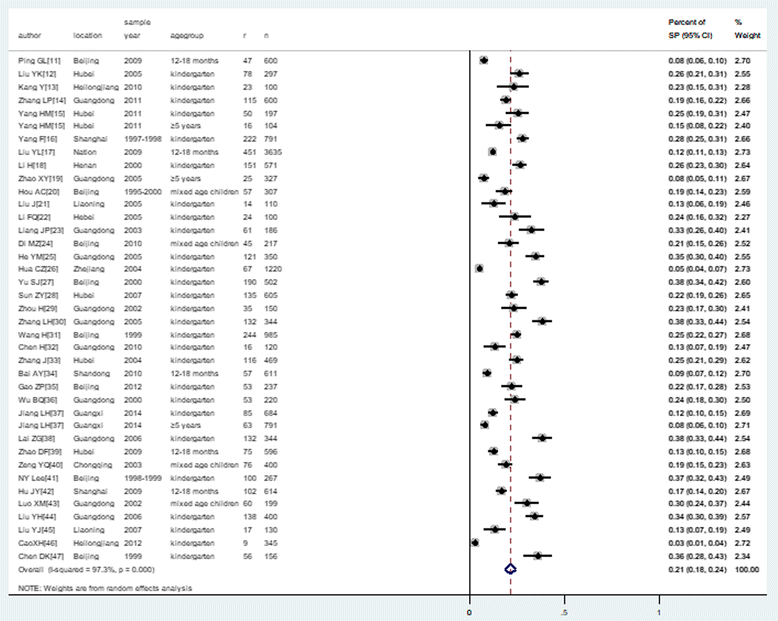
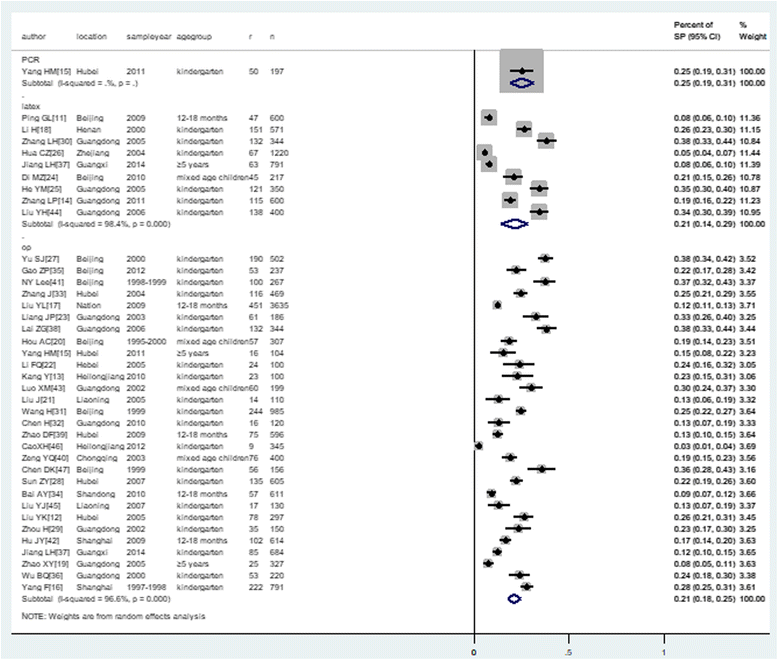

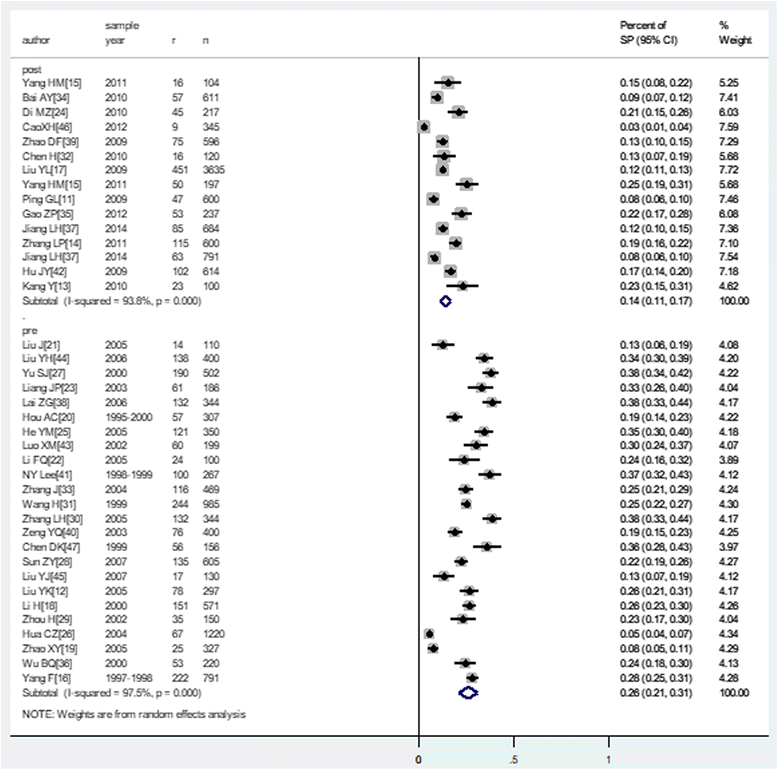
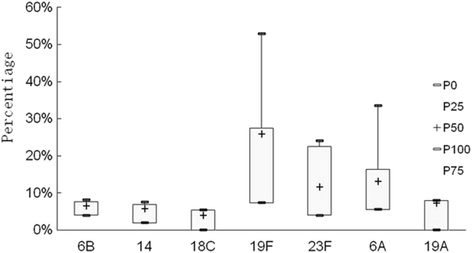
Similar articles
-
The impact of a pneumococcal conjugate vaccination program on the nasopharyngeal carriage, serotype distribution and antimicrobial resistance of Streptococcus pneumoniae among healthy children in Turkey.Vaccine. 2016 Jul 19;34(33):3894-900. doi: 10.1016/j.vaccine.2016.05.043. Epub 2016 Jun 11. Vaccine. 2016. PMID: 27269059
-
Impact of PCV7 vaccination on nasopharyngeal carriage and antimicrobial resistance among children in Turkey.J Infect Dev Ctries. 2019 Mar 31;13(3):227-232. doi: 10.3855/jidc.10833. J Infect Dev Ctries. 2019. PMID: 32040452
-
The impact of private use of PCV7 in 2009 and 2010 on serotypes and antimicrobial resistance of Streptococcus pneumoniae carried by young children in Portugal: Comparison with data obtained since 1996 generating a 15-year study prior to PCV13 introduction.Vaccine. 2016 Mar 29;34(14):1648-56. doi: 10.1016/j.vaccine.2016.02.045. Epub 2016 Feb 23. Vaccine. 2016. PMID: 26920470
-
The impact of pneumococcal conjugate vaccines on serotype 19A nasopharyngeal carriage.Expert Rev Vaccines. 2019 Dec;18(12):1243-1270. doi: 10.1080/14760584.2019.1675521. Expert Rev Vaccines. 2019. PMID: 31587592
-
Impact of pneumococcal conjugate vaccine on infections caused by antibiotic-resistant Streptococcus pneumoniae.Clin Microbiol Infect. 2009 Apr;15 Suppl 3:16-20. doi: 10.1111/j.1469-0691.2009.02726.x. Clin Microbiol Infect. 2009. PMID: 19366365 Review.
Cited by
-
Limited protection of pneumococcal vaccines against emergent Streptococcus pneumoniae serotype 14/ST876 strains.Infection. 2024 Jun;52(3):801-811. doi: 10.1007/s15010-023-02110-y. Epub 2023 Nov 2. Infection. 2024. PMID: 37919621 Free PMC article.
-
Effect of pneumococcal conjugate vaccine availability on Streptococcus pneumoniae infections and genetic recombination in Zhejiang, China from 2009 to 2019.Emerg Microbes Infect. 2022 Dec;11(1):606-615. doi: 10.1080/22221751.2022.2040921. Emerg Microbes Infect. 2022. PMID: 35135440 Free PMC article.
-
Exploring factors shaping antibiotic resistance patterns in Streptococcus pneumoniae during the 2020 COVID-19 pandemic.Elife. 2024 Mar 7;13:e85701. doi: 10.7554/eLife.85701. Elife. 2024. PMID: 38451256 Free PMC article.
-
Pneumococcal carriage in children with COVID-19.Hum Vaccin Immunother. 2021 Jun 3;17(6):1628-1634. doi: 10.1080/21645515.2020.1849516. Epub 2021 Jan 15. Hum Vaccin Immunother. 2021. PMID: 33449815 Free PMC article.
-
A longitudinal hospital-based epidemiology study to assess acute otitis media incidence and nasopharyngeal carriage in Korean children up to 24 months.Hum Vaccin Immunother. 2020 Dec 1;16(12):3090-3097. doi: 10.1080/21645515.2020.1748978. Epub 2020 Apr 24. Hum Vaccin Immunother. 2020. PMID: 32330397 Free PMC article.
References
-
- World Health Organization. Estimated Hib and pneumococcal deaths for children under 5 years of age, 2008.
Publication types
MeSH terms
Grants and funding
LinkOut - more resources
Full Text Sources
Other Literature Sources
Medical

